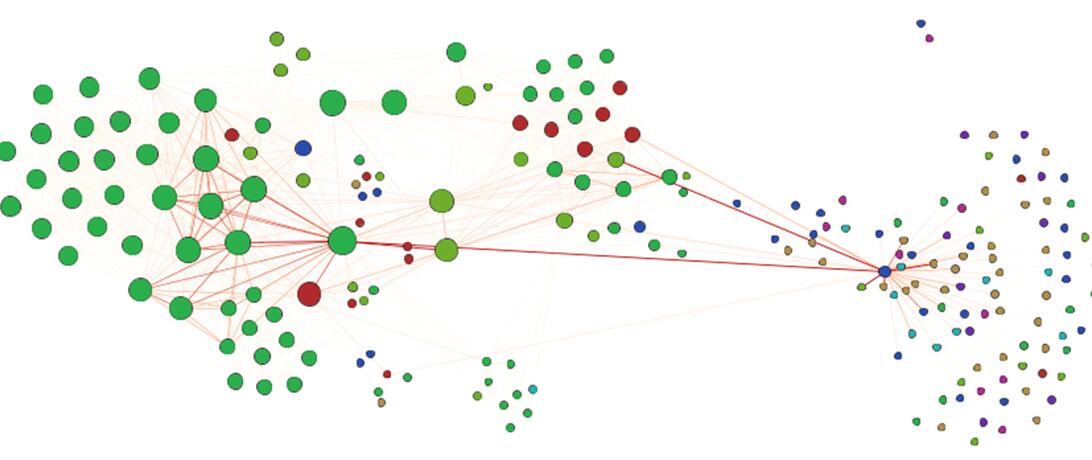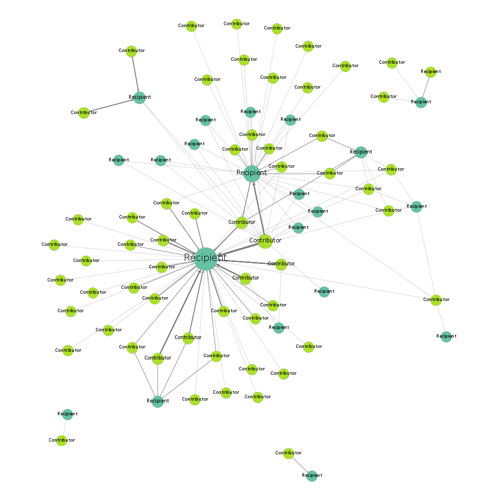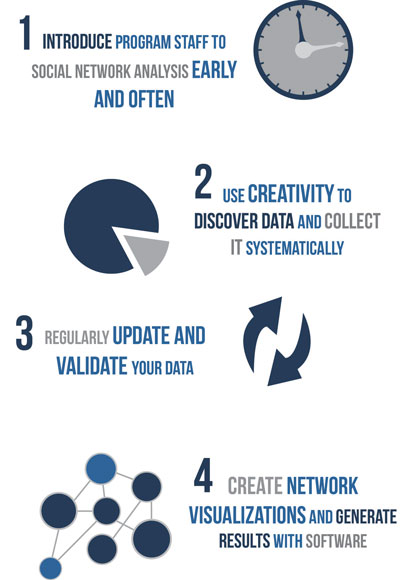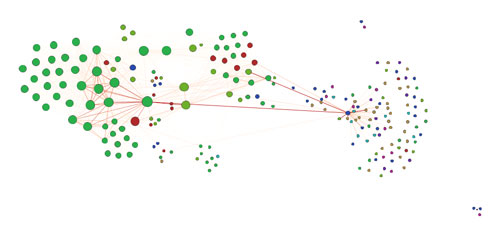
Any global development strategy benefits from collaboration, especially when dealing with issues of considerable complexity and scale. In this post, we discuss social network analysis (SNA) - a useful and adaptable research and evaluation method that can be used by non-profit organizations to assess the degree of cooperation and collaboration in a network.
SNA is widely applicable - advocacy organizations can identify change-makers, evaluators can assess the influence of key actors, and program managers can identify collaboration strategies to move their program forward. Because of its wide applicability, SNA is an appropriate tool for various contexts where
- changes in social capital need to be measured,
- collaboration or coordination are necessary for social change, and/or
- effective information flows are important for achieving programmatic goals.
 We used this method to examine three distinct networks important to our organization: West African counter-piracy efforts, fisheries management in Somalia, and our social media communications. In turn, our program staff used the results to
We used this method to examine three distinct networks important to our organization: West African counter-piracy efforts, fisheries management in Somalia, and our social media communications. In turn, our program staff used the results to
- understand their position in the network;
- understand the state of the overall network, including the number and distribution of actors involved, the number of relationships formed, and the strength of those relationships;
- understand how the network changed based on various strategies, tactics, and activities of the program and other actors, as well as world events;
- discover gaps, weaknesses, and inefficiencies in the network structure; and,
- discover potential pathways for generating new connections with desired actors or, alternatively, for bypassing uncooperative actors.
By sharing our own experiences using SNA, we hope to provide concrete tips on how to effectively begin using the method to explore network characteristics and glean practical information to inform decisions.
Recommended steps based on what we learned
-
Introduce program staff to SNA early and often for increased buy-in and to maximize use of the results.
SNA may be completely unfamiliar to program managers and staff. By understanding the goals of their program, you can guide them through the potential findings and uses of the results. To this end, you should inquire about what network information would help to move their program forward. For example, if stakeholders want to identify actors from an unfamiliar sector like industry to foster multi-sector ties, you could focus data collection on activities involving that sector.
While communicating with your stakeholders, it is also important to discuss and set a timeline for the project to ensure that your analysis remains relevant to your program staff.
2. Use creativity to discover data and collect it systematically for a more manageable and fruitful process.

To assess network development and change, you need information on actors and their relationships with others in that network. Ideally, you should survey or interview most, if not all, actors to capture information about the quality of relationships and perceptions of cooperation and collaboration within that network. However, surveys and interviews may not be appropriate or feasible under some circumstances. In our case, we opted not to use these methods to collect data due to the sensitive nature of topics addressed by our organization, and the nascent, potentially fragile nature of some relationships.
Nevertheless, we were able to collect network information through other methods. For each of our projects, we relied on three other sources of data that proved to be useful and dependable:
- external, archival data, which ranged from published conference reports, project documents, news articles and even publicly available budget reports;
- internal organizational data, such as staff reports; and,
- internal discussions with program staff.
Archival data sources provided a breadth of documented, unbiased information about actors in the larger networks. Internal staff reports and discussions with program staff helped us generate an initial list of relevant actors and partners that were fundamental to their networks. Thus, we successfully gathered relevant and useful network information despite not having direct access to all actors in their networks.
 Uncovering network data may require you to do some systematic digging. International, multi-stakeholder networks often contain hundreds of actors engaged in thousands of relationships. Given this expansiveness, the data can become unwieldy. To make the data collection process manageable, consider the following good practices:
Uncovering network data may require you to do some systematic digging. International, multi-stakeholder networks often contain hundreds of actors engaged in thousands of relationships. Given this expansiveness, the data can become unwieldy. To make the data collection process manageable, consider the following good practices:
- Compile an exhaustive list of relevant and specific keywords in partnership with program staff to optimize archival data collection;
- Perform foreign language searches, if dealing with international networks; and,
- Cross-reference your data with other existing evidence and through discussions with program staff
3. Regularly update and validate your data to ensure the accuracy and timeliness of your analysis.
Due to the slow-moving nature of policy change in international networks, we updated and validated our data on a quarterly basis. After each data collection period, we manually reviewed our data to ensure
- the exclusion of duplicate actors, and
- the exclusion of duplicate relationships – recorded from disparate data sources.
It is good practice to verify your data with program staff. In our case, we met with program staff after each quarterly data update. These regular meetings allowed us to share any new interactions we discovered with our stakeholders and, in turn, allowed them the opportunity to substantiate the new and persistent actors in their network. These meetings also allowed program staff to add data to the network by sharing any undocumented information from meetings or events that they attended.
4. Create network visualizations and generate results using SNA software.
Once you have collected and validated your network data, the next step is to visually communicate that information. In addition to visually communicating your data, it is important to explain why the actors involved and the relationships among them matter. There are a number of metrics that reveal more deep-seated network characteristics, such as the relative influence of each actor and the overall efficiency of the network (see here for a great introduction to SNA measures). Luckily, there is a wealth of software programs that you can use to visualize and analyze your network data.
Choose a tool appropriate for your budget and skill level.

We chose the open-source, interactive visualization platform Gephi. After trying a few other available programs like NodeXL, NetLogo, and R, we settled on Gephi because it offered three key functionalities - powerful, adaptive visualizations, a capacity to handle and manipulate large datasets, and a small learning curve - all at no cost. Gephi is a point-and-click tool that both visualizes and analyzes network data in a single platform while requiring no advanced programming skills.
Become a frequent visitor to online forums and user guides.
A wide number of useful resources and vibrant communities exist online and can be of tremendous help when learning to use Gephi (see the links above for Gephi resources that we found particularly useful). If you choose to work with Gephi, take the time to explore these resources and save them in a place for quick reference.
What we would do differently
Network analysis can uncover a great deal about the mutable cooperation and collaboration among actors in a network. However, SNA is data-driven and can only be as strong as the data behind it. Given the complexity of relationships, many details occur off the cuff and are not immediately obvious or shared publicly. To uncover these details, it is important to ask actors questions that pertain to their network.
Use surveys and interviews to uncover hidden details behind relationships.

Surveys or interviews produce ideal data for network analysis. They can reveal a lot about the quality of relationships in that network. By using these methods, you can answer questions about an actor’s motivation for being a member in a particular network, an actor’s perception of their relationships with others, and new information where archival data falls short. With greater information about the perceptions and motivations of network actors, you can identify actors that are champions for or challengers to the goal of the network. Surveys and interviews also supplement internal staff reports and staff points-of-view that only reveal an insider’s perspective. Having both survey and internal evidence can help reflect the complete state of the network.
Use surveys and interviews to provide detailed profiles on the primary stakeholders.
Once important actors within the network are identified, it may be useful to assess the strategic importance of those actors through approaches like stakeholder mapping. Survey and interview data can provide information for developing detailed profiles of each stakeholder in a network, including the actor’s role and influence in the network.
Final Thoughts
As a tool, SNA can provide invaluable insights to non-profit organizations that work in the complex area of social change. However, any new analytical tool comes with a learning curve, and SNA is no different. It’s always helpful to start with a well formulated plan that outlines why you are using SNA and how it will help move program goals forward. Regularly revisit this plan after meeting with your stakeholders and make modifications to maintain the relevance to your stakeholder’s outcomes.
Article Details
Published
Topic
Program
Content Type
Opinion & Insights